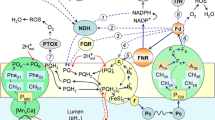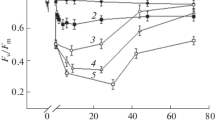Abstract
A brief review is given of investigations on stres-induced alterations of ms-to s-luminescence yield of chlorophyll in plants. Three different approaches are considered: phytoluminography, luminescence-temperature curves, and luminescence induction curves. The remainder of this article presents new results of the effect of heat stress on luminescence induction curves of isolated chloroplasts. Three parameters with widely different heat resistances were resolved from induction curves. A fast valinomycin sensitive transient, L'i, with a 50% inhibition temperature of 33 to 34°C was correlated with the magnitude of the light-induced membrane potential after heat pretreatment. A slower nigericin sensitive transient, L'm, with a 50% inhibition temperature of 39 to 40°C was mainly correlated with the light-induced proton gradient. An uncoupler resistant part of the induction curve, L0, was enhanced by heat stress (half maximum after pretreatment at 46°C) and was correlated with the degree of inhibition of oxygen evolution. Since L0 was also raised by other treatments impairing the oxygen evolving enzyme system, and since this rise was inhibited by DCMU and hydroxylamine, this type of luminescence was ascribed to the intrinsic backreaction. We conclude that luminescence induction curves can serve as an useful indicator of the intactness of the membrane potential, the proton gradient, and the oxygen evolving enzyme system in isolated chloroplasts after heat stress.
Similar content being viewed by others
Abbreviations
- 9-AA:
-
9-aminoacridine
- CCCP:
-
carbonylcyanide m-chlorophenylhydrazone
- ΔA518 :
-
light-induced absorbance change at 518 nm
- ΔAon, ΔAoff :
-
rapid ΔA518 upon switching actinic light on or off, respectively
- Li, Lm, L0 :
-
in this order, initial spike, main maximum, uncoupler insensitive transient of luminescence induction curve
- L'i =:
-
Li − L0
- L'm =:
-
Lm − L0
- P, P680:
-
primary donor of PS II
- PFD:
-
photon flux density (400–700 nm)
- QA :
-
primary acceptor of PS II
References
Alexandrov VYa and Dzhanumov DA (1972) The effect of heat injury and heat-hardening on a photoinduced lasting after-luminescence of Tradescantia fluminensis Vell. leaves. Tsitologia 14: 713–720
Barber J and Kraan GPB (1970) Salt-induced light emission from chloroplasts. Biochim Biophys Acta 197: 49–59
Baumann H (1970) Die verzögerte Fluoreszenz des Chlorophylls in lebenden Pflanzen. PhD Thesis, Technische Hochschule Aachen, FRG
Bilger W and Schreiber U (1989) Modulation of millisecond chlorophyll luminescence by non-photochemical fluorescence quenching. Z Naturforsch 44c: 966–970
Björn LO and Forsberg AS (1979) Imaging by delayed light emission (Phytoluminography) as a method for detecting damage to the photosynthetic system. Physiol Plant 47: 215–222
Crofts AR and Wraight CA (1983) The electrochemical domain of photosynthesis. Biochim Biophys Acta 726: 149–185
Döring G (1975) Further results on the photoactive chlorophyll a 11 in photosynthesis. Biochim Biophys Acta 376: 274–284
Dzhanumov DA, Veselovskii VA, Tarusov BN, Marenkov VS and Pogosyan SJ (1970) Temperature resistance of plants studied by methods of spontaneous and photo-induced chemiluminescence. Fiziologiya Rastenii 18: 588–593
Eckert H-J, Renger G and Witt HT (1984) Reduction kinetics of the photo-oxidized chlorophyll a II + in the nanosecond range. Measurements of the absorption changes at 688 nm under repetitive flash excitation. FEBS Lett 167: 316–320
Ellenson JL (1985) Phytoluminographic detection of dynamic variations in leaf gaseous conductivity. Plant Phys 78: 904–908
Ellenson JL and Amundson RG (1981) Delayed light imaging for early detection of plant stress. Science 215: 1104–1106
Ellenson JL and Raba RM (1983) Gas exchange and phytoluminography of single red kidney bean leaves during periods of induced stomatal oscillations. A demonstration of an integrated, spatially resolving physiometric technique. Plant Physiol 72: 90–95
Fork DC, Mohanty P and Hoshina S (1985) The detection of early events in heat disruption of thylakoid membranes by delayed light emission. Physiol Veg 23: 511–521
Fork DC, Sen A and Williams WP (1987) The relationship between heat-stress and photobleaching in green and blue-green algae. Photosynth Res 11: 71–87
Fork DC and Murata N (1990) The effect of light intensity on the assay of the low temperature limit of photosynthesis using msec delayed light emission. Photosynth Res 23: 319–323
Gerken S, Dekker JP, Schlodder E and Witt HT (1989) Studies on the multiphasic charge recombination between chlorophyll a II + (P-680+) and plastoquinone QA - in photosystem II complexes. Ultraviolet difference spectrum of Chl-a II +/Chl-a II. Biochim Biophys Acta 977: 52–61
Govindjee and Jursinic PA (1979) Photosynthesis and fast changes in light emission by green plants. In: Smith KC (ed) Photochemical and Photobiological Reviews, Vol 4. New York, London: Plenum Press
Havaux M and Lannoye R (1983) Temperature dependence of delayed chlorophyll fluorescence in intact leaves of higher plants. A rapid method for detecting the phase transition of thylakoid membrane lipids. Photosynth Res 4: 257–263
Havaux M and Lannoye R (1984) Effects of of chilling temperatures on prompt and delayed chlorophyll fluorescence in maize and barley leaves. Photosynthetica 18: 117–127
Havaux M and Lannoye R (1985) In vivo chlorophyll fluorescence and delayed light emission as rapid screening techniques for stress tolerance in crop plants (review). Z Pflanzenzücht. 95: 1–13
Havemann J and Lavorel J (1975) Identification of the 120 μs phase in the decay of delayed fluorescence in spinach chloroplasts and subchloroplast particles as the intrinsic backreaction. Biochim Biophys Acta 408: 269–283
Havemann J and Mathis P (1976) Flash-induced absorption changes of the primary donor of PS II at 820 nm in chloroplasts inhibited by low pH or Tris-treatment. Biochim Biophys Acta 440: 346–355
Heber U (1973) Stoichiometry of reduction and phosphorylation during illumination of intact chloroplasts. Biochim Biophys Acta 305: 140–152
Itoh S, Katoh S and Takamiya A (1971a) Studies on the delayed light emission in spinach chloroplasts. II. Participation of primary electron donor and acceptor of photo-reaction II in producing the delayed light emission. Biochim Biophys Acta 245: 121–128
Itoh S, Murata N and Takamiya A (1971b) Studies on the delayed light emission in spinach chloroplasts. I. Nature of two phases in development of the millisecond delayed light emission during intermittent illumination. Biochim Biophys Acta 245: 109–120
Jensen RH and Bassham JA (1966) Photosynthesis by isolated chloroplasts. Proc Natl Acad Sci USA 56: 1095–1101
Jursinic PA (1986) Delayed fluorescence: current concepts and status. In: Govindjee, Amesz J and Fork DC (eds) Light Emission by Plants and Bacteria, pp 291–328. Orlando: Academic Press
Krause GH and Santarius KA (1975) Relative thermostability of the chloroplast envelope. Planta 127: 285–299
Lavorel J (1975) Luminescence. In: Govindjee (ed) Bioenergetics of photosynthesis, pp 223–317. New York: Academic Press
Lavorel J, Lavergne J and Etienne AL (1982) A reflection on several problems of luminescence in photosynthetic systems. Photobiochem Photobiophys 3: 287–314
Lemasters JJ and Hackenbrock CR (1978) Firefly luciferase assay for ATP production by mitochondria. In: Deluca MA (ed) Bioluminescence and Chemiluminescence. Methods of Enzymology, Vol LVII. London, New York: Academic Press
Malkin S (1977) Delayed luminescence. In: Barber J (ed) Primary Processes of Photosynthesis, pp 349–432. Amsterdam: Elsevier
Mayne BC and Clayton RK (1966) Luminescence of chlorophyll in spinach chloroplasts induced by acid-base transition. Proc Natl Acad Sci USA 55: 494–497
Melcarek PK and Brown GN (1977) Effects of chill stress on prompt and delayed chlorophyll fluorescence from leaves. Plant Physiol 60: 822–825
Pukacki P, Veselovsky VA and Veselova TV (1983) Effect of cold dehardening on delayed fluorescence of spruce needles. Z Pflanzenphys 109: 267–273
Satoh K and Katoh S (1983) Induction kinetics of millisecond-delayed luminescence in intact Bryopsis chloroplasts. Plant Cell Physiol 24: 953–962
Schwab BK, Schreiber U and Heber U (1989) Response of photosynthesis and respiration of resurrection plants to desiccation and rehydration. Plant 177: 217–227
Schlodder E, Gräber P and Witt HT (1982) Mechanism of phosphorylation in chloroplasts. In: Barber J (ed) Electron Transport and Phosphorylation, pp 105–175. Amsterdam: Elsevier
Schreiber U and DelValle Tascon S (1982) ATP synthesis with single turnover flashes in spinach chloroplasts. FEBS Lett 150: 32–37
Schreiber U and Bilger W (1987) Rapid assessment of stress effects on plant leaves by chlorophyll fluorescence measurements. In: Tenhunen JD, Catarino FM, Lange OL and Oechel WC (eds) Plant Response to Stress. Functional Analysis in Mediterranean Ecosystems, pp 27–53. Berlin: Springer Verlag
Schuldiner S, Rottenberg H and Avron M (1972) Determination of ΔpH in chloroplasts. 2. Fluorescent amines as a probe for the determination of ΔpH in chloroplasts. Eur J Biochem 25: 64–70
Sundbom E and Björn LO (1977) Phytoluminography: imaging plants by delayed light emission. Physiol Plant 40: 39–41
Terzaghi WB, Fork DC, Berry JA and Field CB (1989) Low and high temperature limits to photosynthesis: A survey using trans-parinaric acid, delayed light emission, and F0 chlorophyll fluorescence. Plant Physiol 91: 1494–1500
vanHasselt PR and vanBerlo HAC (1980) Photooxidative damage to the photosynthetic apparatus during chilling. Physiol Plant 50: 52–56
Vredenberg WJ (1981) P515: A monitor of photosynthetic energization in chloroplast membranes. Physiol Plant 53: 598–602
Weis E (1981) Reversible effects of high, sublethal temperatures on light-induced light-scattering changes and electrochromic pigment absorption shift in spinach leaves. Z Pflanzenphysiologie 101: 169–178
Wraight CA and Croft AR (1971) Delayed fluorescence and the high-energy state of chloroplasts. Eur J Biochem 19: 386–397
Yamashita T and Butler WL (1968a) Inhibition of chloroplasts by UV-irradiation and heat-treatment. Plant Physiol 43: 2037–2040
Yamashita T and Butler WL (1968b) Photoreduction and photophosphorylation with Tris-washed chloroplasts. Plant Physiol 43: 1978–1986
Yordanov I, Goltsev V, Stoyanova T and Venediktov P (1987) High-temperature damage and acclimation of the photosynthetic apparatus. I. Temperature sensitivity of some photosynthetic parameters of chloroplasts isolated from acclimated and non-acclimated bean leaves. Planta 170: 471–477
Author information
Authors and Affiliations
Rights and permissions
About this article
Cite this article
Bilger, W., Schreiber, U. Chlorophyll luminescence as an indicator of stress-induced damage to the photosynthetic apparatus. Effects of heat-stress in isolated chloroplasts. Photosynth Res 25, 161–171 (1990). https://doi.org/10.1007/BF00033158
Received:
Accepted:
Issue Date:
DOI: https://doi.org/10.1007/BF00033158




